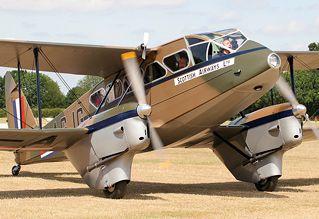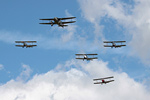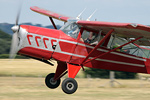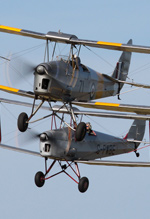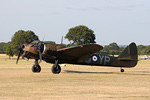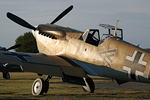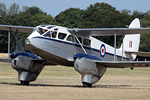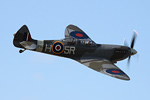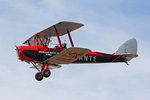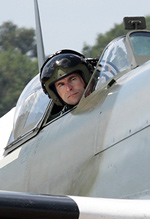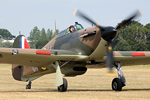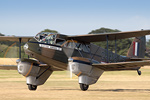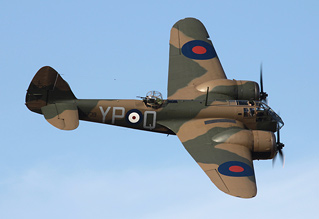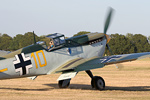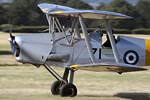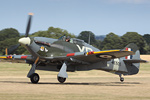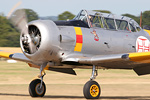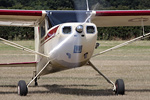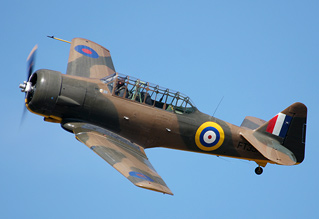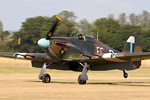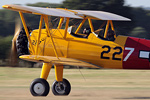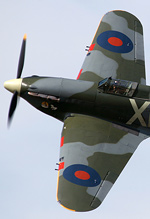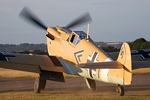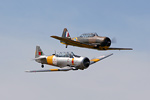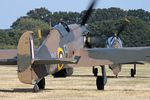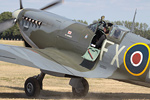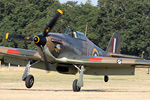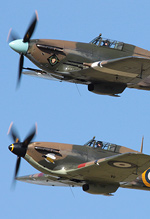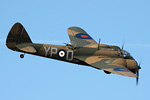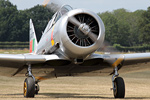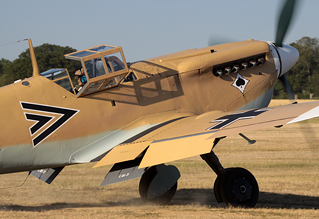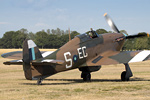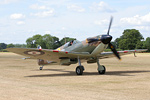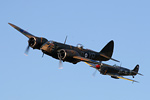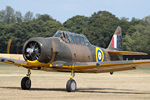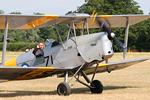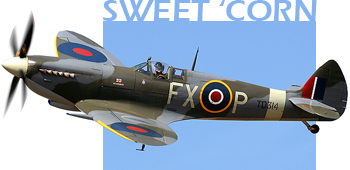
Headcorn 'Battle of Britain' Airshow Report
Saturday 11th July 2015
Vintage aeroplanes on an historic Second World War grass strip, in golden July late-afternoon sunshine. The promise of multiple Spitfires and Hurricanes, and rumours of a landing from the nation's new favourite warbird. And for half the cost of a ticket for Flying Legends. When put like that, taking a punt on Headcorn's Battle Of Britain 75th anniversary airshow seemed an absolute no-brainer. And so it proved
reports from Headcorn in Kent. Additional images from .
People make an airshow as much as aeroplanes do. Yes, there's the pilots, the groundcrews, the display director, the cadets parking your car for you, even the folks who plumb in the notorious "thunderboxes" - but perhaps more than you might think, it's the crowd who make the airshow experience what it is.
We've all been there. The rudeness, the jostling, pushing, shoving, elbowing, camera-bag-treading, rope-twanging. Those who think that turning up late still entitles them to that foot of crowdline staked out by someone who had the nous to arrive at the crack of dawn, waiting in their car until the gates opened. Guess what? At Headcorn there was none of that.
OK, it wasn't quite the genteel garden party of an Old Warden or Goodwood, but certainly in the area in which this writer was positioned, people were not only respectful of personal space, but they were actually friendly, chatty and, shock horror, despite being "general public" were keen to ask sensible questions. The only black mark against them was that they did, at least once, laugh at one of Ken Ellis' jokes.
It's pretty clear this show is going to score highly with us, so let's get the negatives out of the way. We'll start with Mr Ellis. His chirpy Scouse-tinged tones are far from offensive, but sadly he fails massively as an airshow commentator in that he simply refuses to keep the crowd informed of what is happening. Not once did he run through the flying display "order of battle", nor did he offer any explanation, or even mention, the couple of cancellations on the day. In truth he didn't seem to know an awful lot - perhaps he was being fed duff information from the tower and display director Debs Leggett, or perhaps he was being fed none at all, but aside from being a rather insistent official programme pusher, Ken was the proverbial chocolate fireguard.
Another negative, and perhaps a throwback to previous Headcorn events where the crowds may have been far smaller, was the decision to hand a 40ft chunk of prime fenceline to, in all seriousness, a model railway. Yes, the engines were delightfully built, and the folks manning the stall were utterly charming, but plonking that slap-bang in prime viewing territory was madness. At less relaxed venues, this would have been a major flashpoint. As it was, families were content to sit behind the track and gazebo and watch from there, but the organisers folly in losing such a large area of crowdline suggested a lack of experience in organising a decent-sized airshow.
Flying began, despite Ken's promises to the contrary, some ninety minutes after the advertised time of 2:30pm. This meant that for photography, light had just begun to creep around to our disadvantage, but the morning and early afternoon arrivals had enjoyed near-perfect conditions, as indeed the rest of the show did. Though not near-perfect enough for airshow sacred cows the Battle of Britain Memorial Flight. Arriving in a glorious four-ship of "Baby Spitfire" IIa P7350, Spitfire Vb AB910 and their pair of Hurricane IIc fighters LF363 and PZ865, the Flight determined that the crosswind was too great to risk those flimsy canvas and string, underpowered, fragile Spitfires for the actual display. Luckily civilian operators had brought proper, metal ones, and they flew theirs without such ludicrous over-caution. One, Aero Legends' Spitfire IX TD314 was even displayed by the BBMF's Antony Parkinson, as if to further underside, sorry underline, the RAF's sometimes embarrassing reticence to take to the air in their fabulous historic aeroplanes.
Four Hurricanes were present, and all "landed-on", giving the crowd spectacular views of the machines brought in not only by the BBMF, but also Peter Teichman's stellar Hurricane IIb "Pegs" and the Peter Vacher-owned Hurricane I, R4118.
The BBMF displayed their pair, in time-honoured underwhelming fashion. We counted five near-identical underside passes, with only the opening of the routine offering anything approaching a pleasing photographic aspect.
Spitfire fans were well catered-for too. In addition to the RAF's Marks IIa and Vb and Aero Legends' Spitfire IX, the Aircraft Restoration Company's (ARCo) two-seat TR.IX PV202 was present, and there were non-landing appearances by the US-based Mk.IX SL633, shipped over for Duxford's warbird event, and an unplanned (and, thanks again Ken, unannounced) mini-display in the morning from "Kent Spitfire" IXe TA805.
This was a show confident enough in its content and audience to avoid booking the type of acts traditionally brought in to pad out an airshow, namely aerobatic and light types. The closest we got to "filler" was a superb selection of vintage biplanes - Tiger Moths, a Thruxton Jackaroo and Mark and David Miller's best-in-the-country de Havilland Rapide G-AGJG. Local boy Rob Davies displayed effectively over his garden fence in his Boeing Stearman, and there was an excellent pairs display flown by a couple of North American T6 Texans. Harvards to you and I. "Enemy" aircraft on the airfield were represented by the Bucker Bestmann alone, after Peter Holloway's Fieseler Storch cancelled.
For the purist though, the star of the show was always going to be ARCo's Bristol Blenheim I. With the commentator's determination not to tell us anything of use, it was left to Twitter to inform us, and our neighbours, that the aeroplane was indeed inbound. Then Ken sprang into action, breaking character to announce it was fifteen minutes out. Fifteen Ken minutes equates, apparently, to three Earth minutes, as the eagle-eyed spotted the glorious shape lurking on the horizon, as John Romain brought her in to display.
What followed was as priceless as the Blenheim herself. A warbird display without equal. Graceful, gentle, swooping turns showing off this unique aeroplane's lines perfectly. I don't know if Romain is a photographer, but he certainly seems to "get" what we're looking for in a display, right down, it seemed, to putting her in the right piece of sky to make the most of the far-from-perfect sun position. Those nearby broke into spontaneous applause when the Blenheim's official display was complete. They may not have been the most knowledgeable airshow crowd, but they knew good, entertaining, thoughtful flying when they saw it.
And then, another bonus, she dropped her gear to land!
The show proper closed with a well-choreographed set-piece, as the civilian Hurricanes and Spitfires got airborne to "patrol" the Kent skies. Then an air-raid siren and explosions, as pyrotechnics on the airfield simulated a German attack on the airfield. A pair of Hispano HA-1112 Buchons steamed in from Duxford to play the role of Messerschmitt Bf109 bomber escorts, who were duly hunted down by the RAF (though the poor old Hurricane I struggled to keep pace with the more powerful Spits, now joined in the overhead by Spifire IX SL633). This was effectively a tail-chase, and made for compelling viewing, and evocative listening. A lovely end to a remarkably good little airshow.
As with all the best performers, the Blenheim gave us an encore. This was on her departure. She got airborne and teamed up with SL633, returning for a stunning "topside" pass, again using the best of the available light conditions. John Romain, for whom so much of his life has been invested in Blenheims, plural, seems to really relish and enjoy flying this machine - and it more than comes across to the watching audience. She is the finest warbird on the UK register at present, without question, and her display is the one must-see piston routine of the 2015 season.
Might it be an idea that Headcorn becomes an annual, or even biennial fixture in the historic aviation calendar? Flying Legends needs competition to keep The Fighter Collection on their toes, and the plentiful warbirds, for whatever reasons, that TFC seemingly ignore for their event could certainly use the bookings to fill out their diaries.
It was a gamble to skip Duxford's Legends on this sunniest day of the weekend, but one which paid real dividends. A show not without its issues, but one which, at £15 (£12 advance) offered that rarest of commodities in the airshow world - value for money, and gave the warbird purist much to savour both on the ground, and up in those historic Kentish skies.

